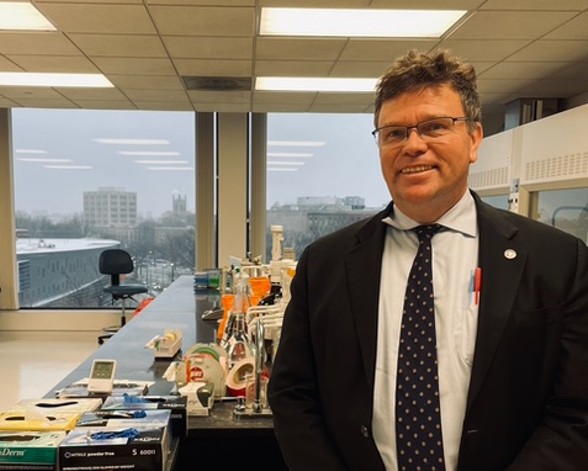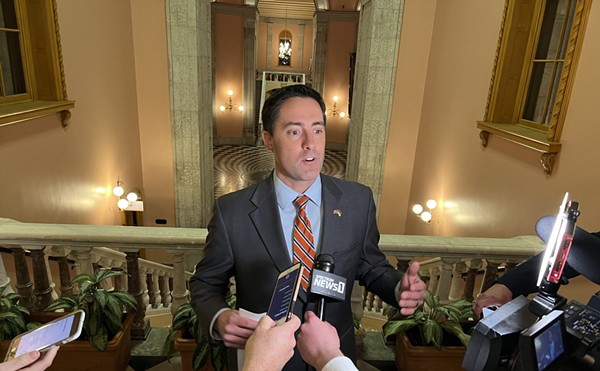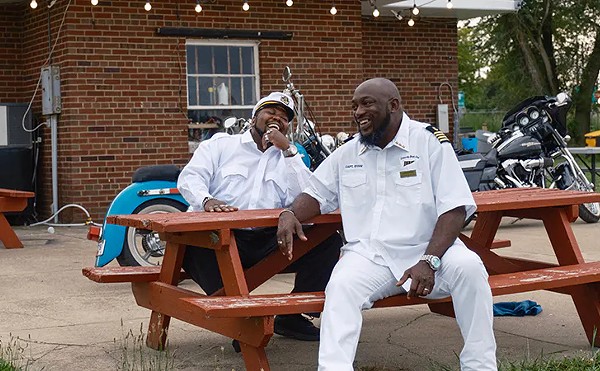Cuyahoga County Chief Medical Examiner Dr. Tom Gilson on Spiking Rates of Teen Suicide and Comforting Families
“Did my child suffer?”
By Dr. Corey Meador on Mon, Feb 6, 2023 at 10:48 am
[
{
"name": "Ad - NativeInline - Injected",
"component": "38482495",
"insertPoint": "3",
"requiredCountToDisplay": "5"
},{
"name": "Real 1 Player (r2) - Inline",
"component": "38482494",
"insertPoint": "2/3",
"requiredCountToDisplay": "9"
}
]
On the third floor of the Cuyahoga County Medical Examiner’s Office, Dr. Tom Gilson tends to a makeshift museum which has become one of his side projects.
It houses vestiges of horrific Cleveland stories past, like the boxer who died at the hands of Sugar Ray Robinson, the notorious torso killer murder mystery, and a slew of car bombing cases (yes, Danny Greene included).
The first autopsy report done in Cleveland from 1833 rests in a glass case and describes the cause of death as drowning in the lake. There are reports from massive Cleveland fires that led to nationwide safety standards changes, like emergency doors opening outwards and fuel stores not being located within a certain distance of residences.
Dr. Gilson has a soft spot for the history of the office. He is just one of four who has held the position in the last 85 years, afer all, and he looks to his predecessors for inspiration.
Asked about his greatest contribution during his 12-year tenure, he points to chaperoning the office into the 21st century with a newfound sense of professionalism.
It is no coincidence, then, that coroner offices across the country often change their title to "medical examiner,” just as Cuyahoga County did. Historically, "coroner" alludes to the task of housing the body for the interest of the King/Crown while the deceased’s outstanding bills are resolved. It’s a far cry from how Dr. Gilson views the office today, which is as the primary care doctor for the city.
What is Cleveland’s primary care doctor seeing now? There's still Covid, and the opioid overdoses continue, but Dr. Gilson is these days thinking about a treacherous upward trend — teen suicide.
This year, a 16-year-old Black teen took his own life with a gun, and Dr. Gilson was in the lab to observe the autopsy. Combined with the police report and the evidence of the tip of the gun touching the teen's skin, there was not much mystery in the autopsy. But the how is not the question people, especially family members ask in these situations.
A common question Dr. Gilson gets from the parents of teens who commit suicide is the more agonizing query to answer: “Did my child suffer?”
What does the the chief medical examiner do?
Medical examiners are medical doctors with a specialty in forensic pathology — the study of the investigation of death. It’s an exclusive group: there are only 500 practicing forensic pathologists in the country.
And while Cleveland should count its blessings in having seven of them, they’re still looking to hire two more (tell your friends). Dr. Gilson was extremely busy in 2022, short-staffed and juggling his various roles.
The chief examiner’s position is very public facing, often testifying before governing bodies and educating the public through the news on death trends. He meets with health departments to bridge the living with the data gathered from the dead. And while many municipalities have their crime forensic lab under the jurisdiction of the police force, Cuyahoga’s falls under the control of Dr. Gilson. He maintains an open-door policy and has a knack for knowing all of his 120+ employees by name.
Despite it all, he still performs autopsies, especially at the end of 2022 when the work was piling up, in the form of bodies. He beckoned an old friend to come help. They worked scalpel-in-hand next to each other, contemplating the work like they used to when they trained in New York City.
Since then, he’s glad to have come up for air with new pathologists doing the brunt of the approximate 2,000 autopsies a year. It has given him time to digest the details of the reports, a daunting task that requires a trained eye to see what information matters. This analyzing is foundational to his work and requires delivering to the public correlations and data, things that can inform the living.
In the 2020 report, Dr. Gilson could not ignore one statistic jumping off the page: the rise in cannabinoids in the bodies of the dead. There has been a three-fold increase of marijuana metabolites in the dead processed by the office since 2016, reaching nearly 30%, and over 50% in homicide victims (25% of them with alcohol in their system as well). There has been a rise in the presence of marijuana metabolites in the teens who commit suicide too. But what does any of it mean?
Interpreting the writing on the wall
Dr. Gilson is the first to tell you it is not the job of his office to make final inferences from the data he collects.
For example, a medical examiner in Chicago might see more deaths during a time of extreme heat, and more deaths might then be attributed to heat exhaustion despite the body on the autopsy table being, ehem, dead cold. Dr. Gilson’s purist philosophy restricts his ability to make such a tempting deduction, and he is not quick to say that stresses of daily living on a vulnerable person is the root cause of a death, unless clear evidence is before him.
If a car backfires, and a person is startled and subsequently has a heart attack, did the car backfiring cause them to die? What if the endorphins of intercourse precede a stroke? How would people react if suddenly there was a spike in deaths by car backfiring (worse yet, intercourse) reported from Gilson’s office?
One of the reasons he is heading a new nationwide organization seeking to foster relationships between medical examiners and public health officials is because the ever-complicated data from the dead requires recruitment of other professionals to make meaningful messages to disseminate to the public. Only then can the conversations within society begin about how we die. Lower rates of cancer deaths, a plateau in heart disease, continued overdoses… what does it all mean? The medical examiner's office doesn’t bring the train to the end of the station so to say, but they’re providing fuel to get us there.
Each of the cohorts of data require different levels of urgency. Certainly, a rise in youth suicide rates demands swift attention. 2021 saw a rate of teen suicides nearly triple the amount in 2018, and this follows a trend that Dr. Gilson can't ignore.
Another mysterious trail Dr. Gilson sees is a rise in the number of bullet wounds in victims. Meaning, over the last couple of years, a jump in the the number of murder victims with more than seven bullet wounds. What correlations can be drawn from this? A subset of more violent murderers, ammunition capabilities changing?
To link a trend to the cause remains a scientist’s or investigator’s greatest challenge, and often their greatest pitfall. To say that marijuana causes death, or that humans are becoming more violent would be premature, ill-advised and reductionist. Worst of all, it could be a wrong.
But one thing is indisputable, young Black males are killing themselves at higher rates. Dr. Gilson knows well that middle-aged white men make up the majority of suicide cases and that the stats there are still steady. But to ignore a new group would be negligent.
Did they suffer?
Dr. Gilson has seen some bad things, and his interest in discussing the grotesque that enthralls the public is all but extinct. However, when he speaks with family members, he applies his intimate knowledge of anatomy and death to assist people in the grieving process.
The trajectory of a bullet is always something noted in his autopsy reports, with reference to neuroanatomy, especially as it pertains to how quickly someone perishes. If a bullet reaches the brain stem, he will note this, which certainly means that the moment a bullet is fired the life is lost.
But for some bullets crashing through the skull, they may travel through parts of the brain like the frontal cortex and spare imminent death. There’s often a second bullet in those people who miss the first time.
The truth of the matter is that in the moment when someone takes their own life, it is unlikely that they suffered in their last seconds more than they suffered in the preceding days, months or years. It is with confidence that Dr. Gilson can assure family members that their loved one did not suffer long at the time of death.
But what is of greater interest to the office is how they did suffer in their time of life.
From the ranks of forensic pathologists in Cleveland come credits of defining SIDS (sudden infant death syndrome), identifying signs of child abuse, and standardizing the use of sexual assault kits. And from the greater group comes countless discoveries such as 2nd impact syndrome and chronic traumatic encephalopathy (CTE).
Cuyahoga County’s Medical Examiner Office ethos necessitates the pursuit of knowledge. Whether it is a breakthrough discovery or the sounding of an alarm, we look to Dr. Gilson and his team to tell us where to look. Someday, his contributions will be among the very ranks of the artifacts he holds so dear in his museum.
x988 Is the Suicide Crisis Hotline. If you are having suicidal thoughts please seek help.
The museum at the Medical Examiner’s Office is open to the public by appointment.
Dr. Corey Meador is a practicing family medicine physician in Cleveland who has written for PBS NewsHour and The Washington Post. He obtained degrees from Loyola Marymount University School of Film & Television in Los Angeles and Drexel University College of Medicine.
Coming soon: Cleveland Scene Daily newsletter. We’ll send you a handful of interesting Cleveland stories every morning. Subscribe now to not miss a thing.
Follow us: Google News | NewsBreak | Instagram | Facebook | Twitter
SCENE Supporters make it possible to tell the Cleveland stories you won’t find elsewhere.
Become a supporter today.
Scroll to read more Cleveland News articles
Newsletters
Join Cleveland Scene Newsletters
Subscribe now to get the latest news delivered right to your inbox.












